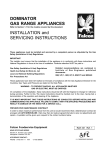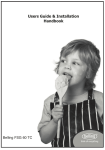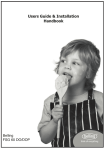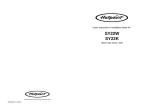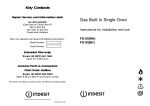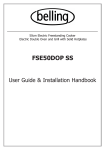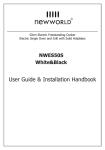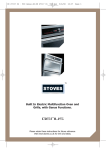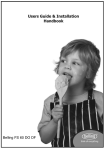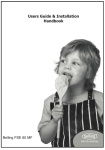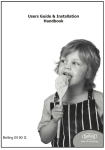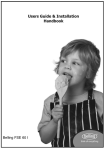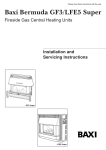Download Belling 644 Electric Kitchen Range
Transcript
23882 06 - SN Gas SI 25/10/2001 16:00 Page 1 Slide In 500mm, 550mm & 600mm wide Freestanding Gas Cookers For Natural Gas Models & LP Gas Models User, Installation & Servicing Instructions RS2/2 23882 06 - SN Gas SI 25/10/2001 16:00 Page 2 If you smell gas: - Do not try to light any appliance. - Do not touch any electrical switch. - Call the Gas Emergency Helpline at TRANSCO on: 0800 111999 The Gas Consumer Council (GCC) is an independent organisation which protects the interests of gas users. If you need advice, you will find the telephone number in your local telephone directory under Gas. The appliance must be installed (and serviced) by a Corgi registered approved installer or a person competent to ensure that the installation is in accordance with “The Gas Safety (Installation and Use) Regulations 1994”, and the “The Gas Safety (Installation and Use) (Amendment) Regulations 1996”. Failure to comply with these Regulations is a criminal offence. 23882 06 - SN Gas SI 25/10/2001 16:00 Page 3 Contents User’s Section . . . . . . . . . . . . . . . . . . . . . . . . . . . . . . . . . . . 2 - 16 Introduction . . . . . . . . . . . . . . . . . . . . . . . . . . . . . . . . . . . . . . . . . . . . . . . 2 Be Safe - Not Sorry. . . . . . . . . . . . . . . . . . . . . . . . . . . . . . . . . . . . . . . . . . 4 Using the Hob . . . . . . . . . . . . . . . . . . . . . . . . . . . . . . . . . . . . . . . . . . . . . 5 Using the Grill . . . . . . . . . . . . . . . . . . . . . . . . . . . . . . . . . . . . . . . . . . . . . 7 Using the Oven . . . . . . . . . . . . . . . . . . . . . . . . . . . . . . . . . . . . . . . . . . . . 9 Slow cooking. . . . . . . . . . . . . . . . . . . . . . . . . . . . . . . . . . . . . . . . . . . . . 10 Baking guide . . . . . . . . . . . . . . . . . . . . . . . . . . . . . . . . . . . . . . . . . . . . . 11 Traditional fruit cakes . . . . . . . . . . . . . . . . . . . . . . . . . . . . . . . . . . . . . . . 12 Roast turkey. . . . . . . . . . . . . . . . . . . . . . . . . . . . . . . . . . . . . . . . . . . . . . 12 Roasting guide . . . . . . . . . . . . . . . . . . . . . . . . . . . . . . . . . . . . . . . . . . . . 13 Minute Minder (if fitted) . . . . . . . . . . . . . . . . . . . . . . . . . . . . . . . . . . . . . . 14 Cleaning. . . . . . . . . . . . . . . . . . . . . . . . . . . . . . . . . . . . . . . . . . . . . . . . 15 Installation Instructions . . . . . . . . . . . . . . . . . . . . Regulations and Standards . . . . . . . . . . . . . . . . . . . . . . . Ventilation Requirements . . . . . . . . . . . . . . . . . . . . . . . . Clearances & dimensions. . . . . . . . . . . . . . . . . . . . . . . . Stability bracket . . . . . . . . . . . . . . . . . . . . . . . . . . . . . . Levelling . . . . . . . . . . . . . . . . . . . . . . . . . . . . . . . . . . . Connect to Electricity supply (mains ignition models only) . . Connect to the Gas supply . . . . . . . . . . . . . . . . . . . . . . . Commissioning. . . . . . . . . . . . . . . . . . . . . . . . . . . . . . . . . . . . . . . . . . . . . . . 17 - 21 . . . . . . . . . . . . 17 . . . . . . . . . . . . 17 . . . . . . . . . . . . 18 . . . . . . . . . . . . 19 . . . . . . . . . . . . 19 . . . . . . . . . . . . 20 . . . . . . . . . . . . 21 . . . . . . . . . . . . 21 Servicing Instructions . . . . . . . . . . . . . . . . . . . . . . . . . . . . . 22 - 26 Technical Data . . . . . . . . . . . . . . . . . . . . . . . . . . . . . . . . . . . . . 27 Stoves Customer Support . . . . . . . . . . . . . . . . . . . . . . . . . . . . . . 28 Please keep this handbook for future reference, or for anyone else who may use the appliance. 1 23882 06 - SN Gas SI 25/10/2001 16:00 Page 4 Introduction Thank you for choosing a British built appliance by Stoves Ventilation The use of a gas cooking appliance results in the production of heat and moisture in the room in which it is installed. Ensure that the kitchen is well ventilated: keep natural ventilation holes open or install a mechanical ventilation device (mechanical extractor hood). Prolonged intensive use of the appliance may call for additional ventilation, for example, opening of a window, or more effective ventilation, for example increasing the level of mechanical ventilation where present. We hope that the following information will help you to familiarise yourself with the features of the appliance, and to use it successfully and safely. Our policy is one of constant development & improvement. Strict accuracy of illustrations and specifications is not guaranteed. Modification to design and materials may be necessary subsequent to publication. This appliance must be installed in accordance with the regulations in force, and only in a well ventilated space. Read the instructions before installing or using this appliance. Moving the cooker Do not attempt to move the cooker by pulling on the doors or handles. Open the door and grasp the frame of the cooker, taking care that the door does not shut on your fingers. Your new appliance is designed to be installed flush to base units. Certain features, such as oven lights, are only available on some models. Take care to avoid damage to soft or uneven floor coverings when moving the appliance. Some cushioned vinyl floor coverings may not be designed to withstand sliding appliances without marking or damage. Your 1st Year Guarantee To fulfil the conditions of your guarantee, this appliance must be correctly installed and operated, in accordance with these instructions, and only be used for normal domestic purposes. Please note that the guarantee, and Service availability, only apply to the UK and Republic of Ireland. 2 23882 06 - SN Gas SI 25/10/2001 16:00 Page 5 Introduction Glass door panels Before using the appliance for the first time, remove any protective polythene film and wash the oven shelves and furniture in hot soapy water, to remove their protective coating of oil. Even so, when you first turn on the oven or grill you may notice a smell and some smoke. To meet the relevant Standards of Domestic cooking appliances, all the glass panels on this appliance are toughened to meet the fragmentation requirements of BS3193. This ensures that, in the unlikely event that a panel breaks, it does so into small fragments to minimise the risk of injury. Please take care when handling, using or cleaning all glass panels as any damage to the surfaces or edges may result in the glass breaking without warning or apparent cause at a later date. Should any glass panel be damaged, we strongly recommend that it is replaced immediately. Stability bracket If the cooker is to be fitted with a flexible inlet connection, a stability bracket should also be fitted to engage in the back of the cooker. Make sure this is re-engaged whenever you move the cooker for cleaning. The cooling fan (if fitted - mains ignition models only) To replace a light bulb (if fitted) Caution: Switch off the electricity supply to the cooker at the socket, to avoid the risk of electric shock. When the appliance is switched on, you may hear the cooling fan come on. This keeps the fascia and control knobs cool during grilling / cooking and will continue to operate for up to 15 minutes after the appliance has been switched off. Wait until the oven is cool before removing the oven shelves. Grasp the lens cover on the light fitting and pull it away from the side of the oven. Unscrew the bulb. During oven use the fan may cycle on and off. Should any fault occur with the cooling fan, the appliance will require servicing. Contact Customer Support. Please note that the oven light bulb is not covered by the guarantee. Replacement bulbs can be ordered from your local supplier, or bought from a hardware store. 3 23882 06 - SN Gas SI 25/10/2001 16:00 Page 6 Introduction Battery ignition models Environmental Protection To fit battery The battery is fitted to the top of the spark generator. The spark generator is located on the rear panel of the appliance. Stoves Limited is committed to protecting the environment and operates an Environmental Management System which complies with BS EN ISO 14001:1996. If the ignition fails: Disposal of packaging ■ Check there is a spark when the ignition switch is operated. • All our packaging materials are recyclable and environmentally friendly. • Please help us to protect our environment by disposing of all packaging in an environmentally friendly manner. • Please contact your local authority for the nearest recycling centre. ■ Check that the gas supply is switched on. ■ Check the battery and replace if necessary. Mains ignition models A plug is fitted with a 3 amp fuse. If the ignition fails: Caution: Packaging materials can pose a risk of suffocation - keep away from children. ■ Check there is a spark when the ignition button is depressed. If there is no spark, check that the electricity supply is switched on at the socket. Gas & Electrical connection Please refer to installation instructions for the Gas & Electrical Safety Regulations and the Ventilation Requirements. ■ Check that the gas supply is switched on. In your own interest, and that of safety, it is the law that all gas appliances be installed by competent persons. Corgi registered installers undertake to work to satisfactory standards. ■ Try another appliance in the socket, if that works, replace the 3 amp fuse in the cooker plug. Models without ignition Disconnection of gas and electric appliances should always be carried out by competent persons. To ignite the burners Use a lighted match or taper - refer to ignition instructions in the hob, grill and oven sections. Warning: This appliance must be earthed. 4 23882 06 - SN Gas SI 25/10/2001 16:00 Page 7 Be Safe - Not Sorry When you are cooking, keep children away from the vicinity of the appliance. ■ Do not use aluminium foil to cover the grill pan, or put items wrapped in foil under the grill as this creates a fire hazard. This product is designed as a domestic cooking appliance for the preparation and cooking of domestic food products, and should not be used for any other purpose. ■ Do not use the oven with the door inner glass panel removed (glass oven doors only). ■ Use oven gloves when removing hot food / dishes from the oven or grill. The oven / grill and utensils will be very hot when in use. ■ Remove all packaging, protective films and oils from the appliance before using for the first time. ■ Make sure you read and understand the instructions before using the appliance. ■ Do not use foil on oven shelves or allow it to block the oven flue, as this creates a fire hazard, and prevents heat circulation. ■ Keep electrical leads short so they do not drape over the appliance or the edge of the worktop. ■ Switch off the electricity supply before replacing the oven light bulb (if fitted) to avoid the risk of electric shock. ■ Keep all flammable materials (such as curtains, furnishings & clothing) away from the appliance. ■ When cooking heavy items - eg; turkeys - do not pull the oven shelf out with the item still on the shelf. ■ Parts of the appliance may be hot during or immediately after use. Allow sufficient time for the appliance to cool after switching off. Drop-down door models: Do not place items on the door when open. ■ Never use the appliance for heating a room. ■ When you have finished cooking check that all controls are in the “off” position. ■ Do not drape tea towels over the flue vents or door, as this creates a fire hazard. All installation, servicing and maintenance work should be carried out by a competent person who will comply with current Regulations, Standards and Requirements. ■ When opening the appliance door, take care to avoid skin contact with any steam which may escape from the cooking. As with all gas appliances, it is recommended that your appliance is serviced regularly. 5 23882 06 - SN Gas SI 25/10/2001 16:00 Page 8 Using the Hob Ignition Pans Push in and turn the selected control knob anticlockwise to the ‘full on’ position and press the ignition switch (if fitted), or hold a lighted match or taper to the burner, until the burner lights. Turn the control knob to the required setting. Use pans with a flat base of minimum 100mm / 4 ins diameter and maximum 280mm / 11 ins diameter which are stable in use. Do not use double pans, rim based pans, old misshapen pans or any pan which is unstable when placed on a flat surface. Adjust the burner flame so that it does not extend over the pan base. Position pans over the centre of the burners, resting on the pan supports. If positioned off centre, smaller pans may be unstable. To turn off, push in the control knob and turn clockwise until the dot on the control knob is below the dot on the facia panel. When cooking with fat or oil, never leave unattended. To simmer Turn pan handles to a safe position, so they are out of reach of children, not overhanging the appliance, and cannot be caught accidentally. The simmer position is marked by the small flame symbol. Once lit turn the selected control knob anticlockwise past the large flame symbol (FULL ON) to the small flame symbol. Commercial simmering aids should not be used as they create excessive temperatures that can damage the surface and may cause a hazard. You may hear a slight popping noise when the hob burners are operating and this is quite normal, but if anything about the cooker appears unusual, such as change in flame appearance, or the operation of controls - seek expert advice. Pan supports Always make sure the pan supports are replaced correctly, and located in the hob spillage well. 6 23882 06 - SN Gas SI 25/10/2001 16:00 Page 9 Using the Hob To save gas The fold down lid ■ Use the size of pan most suited to the size of the burner - ie; larger pans on the larger burners, smaller pans on the smaller burners. Caution: Glass lids may shatter when heated. Turn off all the burners before shutting the lid. When opening and closing the lid, use the cooler outer sides of the lid trim. ■ Adjust the flames so that they do not lick up the sides of the pan. The lid must be opened fully, so there is no danger of it closing while the hob is being used. ■ Put lids on saucepans and only heat the amount of liquid you need. The appliance is fitted with a switchback system, which will automatically turn off the hotplate controls if they are inadvertently left on as the lid is closed. ■ When liquids boil, reduce the control setting to maintain a simmer. ■ Consider the use of a pressure cooker for the cooking of a complete meal. The lid is not intended to be used as a work surface, as it becomes hot when any part of the cooker is in use, and the surface may be scratched if items with rough or sharp surfaces are placed on it. ■ Potatoes and vegetables will cook quicker if chopped into smaller pieces. 7 23882 06 - SN Gas SI 25/10/2001 16:00 Page 10 Using the Grill Caution: Accessible parts may be hot when the grill is used. Young children should be kept away. When slower cooking is required the grill can be turned down anti-clockwise to a slightly reduced setting, past the large flame symbol (full on), to the small flame symbol. This can be used in conjunction with use of the different grilling positions (see below). Ignition Open the grill door. Push in and turn the grill control knob anticlockwise to the “full-on” position. Hold the control knob in and press the ignition switch (if fitted), or hold a lighted match or taper to the burner, until the burner lights. Only use the grill burner between the large and small flame symbol. Natural Gas glass door models & Natural Gas models with no ignition Place the handle over the edge of the grill pan. The handle should be removed from the pan during grilling, to prevent overheating. To turn off, push in the control knob and turn it clockwise to the “off” position. Detachable grill pan handle Do not hold the control knob in for more than 15 seconds. The handle is designed for removing / inserting the grill pan under the grill when grilling. If after 15 seconds the burner has not lit, switch off the grill and leave the compartment door open. Wait at least one minute before a further attempt to ignite the burner. If cleaning the grill pan when it is hot, use oven gloves to move it. Do not use the handle to pour hot fats from the grill pan. All metal door versions (NG & LPG) & all LP Gas versions A few seconds after the flame has established, the safety valve will open and the control knob can be released (this can take up to 1⁄2 minute). In the event of the burner flames being accidentally extinguished, turn off the burner control and do not attempt to reignite the burner for at least one minute. handle grill pan trivet Grill pan trivet Food for grilling should be placed within the area defined by the kinks in the trivet wires. Important: Keep the grill door open when the grill is on. 8 23882 06 - SN Gas SI 25/10/2001 16:00 Page 11 Using the Grill Detachable heatshield (if fitted battery ignition models and models without ignition) Preheating For best cooked results, always preheat the grill for about 3 minutes. Before using the grill, ensure that the detachable heatshield is in place. Aluminium foil Caution: The heatshield becomes very hot when the grill is used. Use oven gloves or allow to cool before removing the heatshield. Using aluminium foil to cover the grill pan or trivet, or putting items wrapped in foil under the grill creates a fire hazard. To fit the heatshield, hold it with both hands against the underside of the fascia panel, and lower (slightly) the edge you are holding to locate the heatshield into the slot behind the fascia panel. Ensure that the right hand edge of the heatshield is level with the right hand side of the appliance, then push firmly home. Grilling There are three different grilling positions, as the grill trivet, which is in the grill pan, may be inverted to give a high or low position or the trivet may be removed. 1. The HIGH trivet position is suitable for toasting bread. 2. The LOW trivet position is suitable for grilling all types of meat & fish. 3. With the grill trivet removed the food is placed directly on the base of the grill pan - eg; when cooking whole fish or browning dishes such as cauliflower cheese. 9 23882 06 - SN Gas SI 25/10/2001 16:00 Page 12 Using the Oven Caution: Accessible parts may be hot when the appliance is in use, young children should be kept away. re-ignite the burner for at least one minute. Preheating Open the oven door. Push in and turn the oven control knob to the full on position (gas mark 9). The oven must be preheated for 15 20 minutes when cooking frozen or chilled foods, and we recommend preheating for yeast mixtures, batters, soufflés, whisked sponges and pastry. Hold the control knob in and press the ignition switch (if fitted), or hold a lighted match or taper to the burner, until the burner lights. If you are not preheating the oven, the cooking times in the following guides may need to be extended, as they are based on a preheated oven. Glass door models & models with no ignition Zones of heat Ignition The temperature at the centre of the oven corresponds with the selected gas mark and is slightly higher towards the top of the oven and slightly lower towards the oven base. Do not hold the control knob in for more than 15 seconds. If after 15 seconds the burner has not lit, switch off the oven and leave the compartment door open. Wait at least one minute before a further attempt to ignite the burner. These zones of heat can be useful as different dishes requiring different temperatures can be cooked at the same time, when more than one shelf is used. Metal door & LPG models (& some glass door versions) The temperature at the oven base is suitable for cooking baked vegetables, baked fruit, milk pudding etc, and for warming bread rolls, soup, coffee, or ovenproof plates and dishes. A few seconds after the flame has established, the safety valve will open and the control knob can be released (this can take up to 1⁄2 minute). Turn the control knob to the required gas mark setting. If you find that over a period of time, the oven becomes hotter when used at a particular gas mark, the thermostat may need to be replaced. To turn off push in the control knob and turn to the “off” position. In the event of the burner flames being accidentally extinguished, turn off the burner control and do not attempt to 10 23882 06 - SN Gas SI 25/10/2001 16:00 Page 13 Using the Oven Baking tray and roasting tins Shelf positions For best cooked results and even browning, the maximum size baking trays and roasting tins that should be used are as follows; The oven shelf must be positioned with the upstand at the rear of the oven and facing up. Position baking trays and roasting tins on the middle of the shelves, and leave 1 clear shelf position between shelves, to allow for circulation of heat. 500mm wide models: Baking tray 290mm x 270mm This size of baking tray will hold up to 16 small cakes. Roasting tin When cooking 2 trays or items, remove the top item when it is cooked and raise the lower item to the higher shelf to finish cooking, or where additional browning of the bases is required - eg; pies and pastries, interchange part way through cooking. 320mm x 270mm 550 & 600mm wide models: Baking tray 350mm x 280mm This size of baking tray will hold up to 16 small cakes. Roasting tin If you prefer darker cooked results, cook on a higher shelf, for paler results use a lower shelf. 370mm x 320mm We recommend that you use good quality cookware. Poor quality trays and tins may warp when heated, leading to uneven baking results. Slow cooking Make sure that frozen foods are thoroughly THAWED before cooking. Do not slow cook joints of meat or poultry weighing more than 21⁄4kg / 41⁄2lb. Baking guide Please note that the times and temperatures stated in the baking guide are only intended for reference only - refer to your recipe. Always use the top half of the oven for slow cooking. For roasting joints of meat or poultry, and for pot roasts preheat the oven to gas mark 6 and cook for 30 minutes, then adjust the oven control to the ‘S’ slow setting for the remainder of the cooking time. Oven light (if fitted) The oven light is operated by the oven light switch, located on the facia. Slow cooking times will be about three times as long as conventional cooking times. 11 23882 06 - SN Gas SI 25/10/2001 16:00 Page 14 Using the Oven Baking guide Dish Recommended gas mark Shelf position Approximate cooking time Scones Meringues 7 “S” slow setting top to middle middle to bottom 8 - 15 mins 3 - 4 hours 5 5 6 4 middle middle middle middle 15 - 25 mins 20 - 30 mins 8 - 15 mins 20 - 35 mins 4 3 2 1 or 2 middle middle to bottom middle to bottom middle to bottom 2 or 3 middle to bottom 20 - 30 mins 11⁄4 - 11⁄2 hours 1 - 11⁄2 hours depending on recipe 21⁄2 - 3 hours Pastry Rough puff & Flaky / Puff Shortcrust & Flan Choux 7 6 6 middle to top middle to top middle to top 15 - 45 mins 15 - 45 mins 20 - 45 mins Biscuits Shortbread fingers Nut brownies Flapjacks Ginger nuts 3 3 4 5 middle middle middle middle to to to to top bottom top top 20 - 30 mins 12 - 18 mins 20 - 40 mins 7 - 12 mins Puddings Rice pudding Baked custard Bread and butter Hot soufflé Fruit crumble 2 2 or 3 3 4 5 middle middle middle middle middle to bottom to bottom to top to top 2 - 21⁄2 hours 1 - 11⁄4 hours 1 - 11⁄4 hours 40 - 50 mins 30 50 mins Bread (2 x 500g) Bread (1 x 1kg) 7 7 middle to top middle to top 20 - 40 mins 30 - 45 mins Cakes Small cakes Whisked sponge Swiss roll Victoria sandwich (2 x 180mm / 7”) Genoese sponge Madeira (180mm/7”) Gingerbread Very rich fruit cake (205mm / 8”) Semi-rich fruit cake (205mm /8”) to to to to top top top top Note: The cooking times given above are based on cooking in a pre-heated oven. 12 23882 06 - SN Gas SI 25/10/2001 16:00 Page 15 Using the Oven Traditional fruit cakes Roast turkey It should be remembered that ovens can vary over time, therefore cooking times can vary, making it difficult to be precise when baking fruit cakes. Roasting turkey involves cooking two different types of meat - the delicate light breast meat, which must not be allowed to dry out, and the darker leg meat, which takes longer to cook. It is necessary therefore, to test the cake before removal from the oven. Use a fine warmed skewer inserted into the centre of the cake. If the skewer comes out clean, then the cake is cooked. The turkey must be roasted long enough for the legs to cook, so frequent basting is necessary. The breast meat can be covered once browned. ■ Do not attempt to make Christmas cakes larger than the oven can cope with, you should allow at least 25mm (1 inch) space between the oven walls and the tin. ■ Always make sure that the turkey is completely thawed and that the giblets are removed before cooking. ■ Turkey should be roasted at gas mark 4 for 20 minutes per 1lb, plus 20 minutes, unless packaging advises otherwise. ■ Always follow the temperatures recommended in the recipe. ■ To protect a very rich fruit cake during cooking, tie 2 layers of brown paper around the tin. ■ The turkey can be open roasted, breast side down, for half of the cook time, and then turned over for the remainder of the cooking time. ■ We recommend that the cake tin is not stood on layers of brown paper, as this can hinder effective circulation of air. ■ If the turkey is stuffed, add 5 minutes per lb to the cooking time. ■ Do not use soft tub margarine for rich fruit cakes, unless specified in the recipe. ■ If roasting turkey covered with foil, add 5 minutes per 1lb to the cooking time. ■ Always use the correct size and shape of tin for the recipe quantities. To test if the turkey is cooked, push a fine skewer into the thickest part of the thigh. If the juices run clear, the turkey is cooked. If the juices are still pink, the turkey will need longer cooking. 13 23882 06 - SN Gas SI 25/10/2001 16:00 Page 16 Using the Oven Roasting guide Notes: The times given in the roasting guide are only approximate, because the size and age of the bird will influence cooking times as will the shape of a joint and the proportion of the bone. ■ When cooking stuffed meat or poultry, calculate the cooking time from the total weight of the meat plus the stuffing. ■ For joints cooked in foil or covered roasters, and for lidded casseroles, add 5 minutes per 450g (1lb) to the calculated cooking time. Frozen meat should be thoroughly thawed before cooking. For large joints it is advisable to thaw overnight. Frozen poultry should be thoroughly thawed before cooking. The time required depends on the size of the bird - eg; a large turkey may take up to 48 hours to thaw. ■ Smaller joints weighing less than 1.25kg (21⁄2lb) may require 5 minutes per 450g (1lb) extra cooking time. ■ Position the oven shelf so that the meat or poultry will be in the centre of the oven. Use of a trivet with a roasting tin will reduce fat splashing and will help to keep the oven interior clean. Alternatively, to help reduce fat splashing, potatoes or other vegetables can be roasted around the meat / poultry. ■ It is recommended that the appliance is cleaned after open roasting. Cook in oven at Gas Mark 5 Approximate Cooking Time (preheated oven) Beef Rare Medium Well done 20 minutes per 450g (1lb), plus 20 minutes 25 minutes per 450g (1lb), plus 20 minutes 30 minutes per 450g (1lb), plus 30 minutes Lamb Medium Well done 25 minutes per 450g (1lb), plus 25 minutes 30 minutes per 450g (1lb), plus 30 minutes Pork 35 minutes per 450g (1lb), plus 35 minutes Poultry 20 minutes per 450g (1lb), plus 20 minutes 14 23882 06 - SN Gas SI 25/10/2001 16:00 Page 17 Minute Minder (if fitted) Initial display Setting the minute minder 1. Press and release the plus button to change the display from clock to minute minder - the bell symbol will light. Time of day button Minus button 2. Use the plus and minus buttons to set the length of time before the alarm tone will sound. The display will increase / decrease in units of 10 seconds up to 99 minutes 50 seconds, and in units of 1 minute from 1 hour 40 minutes upwards. The maximum period which may be set is 10 hours. Plus button The digital timer enables you to set the time of day (24 hour clock) and the minute minder alarm. The display format will change after 99 minutes and 50 seconds to 1 hour and 40 minutes. Setting the “Time of Day” 1. Switch on the electricity supply to the appliance. During countdown, the minute minder has priority on the display, which will show (in minutes : seconds, or hours : minutes) the time remaining. The display will flash. 2. Press and release the time of day button. 3. Set the time of day with the plus and minus buttons. When countdown is complete, the tone will sound for 7 minutes, or it can be reset with one touch of any button. 4. The time will be set 7 seconds after the last plus or minus operation. Alarm tones To cancel the minute minder at any other time, run down the set time with the minus button. After setting the time of day, you can select one of three alarm tones. Press the minus button to listen to the first tone, then release the minus button and press it again to listen to the second tone, etc. The display will revert to show the time of day. Releasing the minus button after a tone has sounded will automatically select that tone. 15 23882 06 - SN Gas SI 25/10/2001 16:00 Page 18 Cleaning Burner caps and heads Caution: Any cleaning agent used incorrectly may damage the appliance. Important: Allow burners to cool before cleaning. Always let the cooker cool before cleaning. Caution: Hotplate burners can be damaged by soaking, automatic dishwashers (or dishwasher powders / liquids), caustic pastes, hard implements, coarse wire wool, and abrasive cleaning pastes. Some cooking operations generate considerable amount of grease, this combined with spillage can become a hazard if allowed to accumulate on the cooker through lack of cleaning. In extreme cases this may amount to misuse of the appliance and could invalidate your guarantee. Clean with a moist soapy pad - eg; “Brillo”. For the burners to work safely, the slots in the burner head where the flames burn need to be kept clear of deposit. Clean with a nylon brush, rinse, and dry thoroughly. It is recommended that the appliance is cleaned after open roasting. Do not use caustic pastes, abrasive cleaning powders, products containing bleach, coarse wire wool or any hard implements, as they will damage the surfaces. Important: The burner caps and heads must be repositioned correctly so that they sit squarely onto the hob as shown. All parts of the appliance can be safely cleaned with a cloth wrung out in hot soapy water. burner cap correct parallel Painted, plastic and metal finish parts (if fitted) METAL DOOR PANEL FRAME PANEL (if fitted), burner head OVEN DOOR & HANDLE, GRILL PAN HANDLE, FACIA & CONTROL KNOBS incorrect Only use a clean cloth wrung out in hot soapy water. angled burner cap not central incorrect 16 23882 06 - SN Gas SI 25/10/2001 16:00 Page 19 Cleaning Easy care oven interior (if fitted) Glass parts (if fitted) OVEN SIDES AND BACK GLASS DOOR PANELS, LID GLASS We recommend that the appliance is cleaned after open roasting, and also after roasting at temperatures higher than gas mark 5, to help prevent a build up of fats. Use of a trivet in a roasting tin when roasting will help reduce fat splashing. Do not use abrasives or polishes as they will scratch and damage the glass. Use a mild cream cleaner - eg; “Cif”. Rinse away excess cleaner and dry with a soft cloth. Warning: Do not operate the appliance without the glass panel correctly fitted. Caution: Most types of cleaning agent will damage these surfaces. Important: the inner door glass panel can be removed for cleaning but it must be replaced the right way up (so the reflective side - if fitted - faces inwards), and pushed fully in to the stop position. To remove the glass panel, open the door wide, hold the top and bottom edges and slide out. Only use a few drops of washing up liquid in hot water. Wipe the surfaces with a clean cloth wrung out in hot soapy water - if larger splashes of fat do not readily disappear scrub the area with a nylon brush or nylon pan scourer and hot soapy water. Rinse well and heat the oven to dry the surfaces. Chrome plated parts OVEN SHELF Vitreous Enamel parts GRILL PAN, HOB TOP & PAN SUPPORTS, OVEN SHELF RUNNERS, GRILL PAN Use a moist soap pad - eg; “Brillo”. COMPARTMENT FLOOR, OVEN COMPARTMENT (WIPE-CLEAN & RUNNERS, GRILL PAN TRIVET Note: Oven shelf runners (if fitted) can be removed for cleaning. Grasp the runners and slide out of the hanging holes as shown. OVENS) Use a mild cream cleaner. Look for one which has the ‘Vitreous Enamel Development Council’s’ recommendation seal - eg; “Cif”. Note: These items may also be cleaned in a dishwasher. Stubborn marks may be removed with a moistened “Brillo” pad. The pan supports and grill pan may be cleaned in a dishwasher, or with a nylon brush in hot soapy water. 17 23882 06 - SN Gas SI 25/10/2001 16:00 Page 20 Installation Instructions Before you start; Ventilation Requirements Check that your appliance is suitable for the gas supply in your house - ie; either Natural Gas only or LP Gas only. This is clearly marked on the data badge. The room containing the appliance should have an air supply in accordance with BS 5440 : Part 2 : 1989: Please read the instructions carefully. Planning your installation will save you time and effort. The appliance must be installed by a Corgi registered approved installer or a person competent to ensure that the installation is in accordance with “The Gas Safety (Installation and Use) Regulations 1994”, and the “The Gas Safety (Installation and Use) (Amendment) Regulations 1996”. Failure to comply with these Regulations is a criminal offence. ■ All rooms require an openable window, or equivalent, and some rooms will require a permanent vent as well. ■ For room volumes up to 5m3 an air vent of 100cm2 is required. ■ If the room has a door that opens directly to the outside, or the room exceeds 10m3 NO AIR VENT is required. ■ For room volumes between 5m3 and 10m3 an air vent of 50cm2 is required. ■ If there are other fuel burning appliances in the same room, BS 5440: Part 2: 1989 should be consulted to determine the air vent requirements. ■ This appliance must not be installed in a bed sitting room of less than 20m3 or in a bathroom or shower room. Where regulations or standards have been revised since this handbook was printed, always use the latest edition. In the UK the regulations and standards are as follows: 1. Gas Safety Regulations (Installation and Use). Windows and permanent vents should therefore not be blocked or removed without first consulting a CORGI gas installer. 1996 2. Building Regulations - Issued by the Department of the Environment. LP Gas only - Do not install this appliance in a room below ground level. This does not preclude installation into rooms which are basements with respect to one side of the building but open to ground level on the opposite side. 3. Building Standards (Scotland) (Consolidated) - Issued by the Scottish Development Department. 4. The current I.E.E. Wiring Regulations. 5. Electricity at Work Regulations 1989. Failure to install appliances correctly is dangerous and could lead to prosecution. 6. BS 6172 Installation of Domestic Gas cooking Appliances Also, for LP Gas refer to BS 5482: Part 1, Part 2 or Part 3 as relevant. 7. Installation & Servicing Instructions for this appliance. 18 23882 06 - SN Gas SI 25/10/2001 16:00 Page 21 Installation Instructions Whilst every care is taken to eliminate burrs and raw edges from this product, please take care when handling - we recommend the use of protective gloves during installation. Clearances Moving the cooker The cooker must have a side clearance above hob level of 90mm up to a height of 400mm. No shelf or overhang or cooker hood should be closer than a minimum of 650mm, but check with cooker hood manufacturer’s recommendations. Please note that the weight of this appliance is approximately 46kg - 500 mm models / 51kg - 550mm models / 53kg - 600mm models (unpacked). This cooker may be fitted flush to base units. However, for models with side opening doors, we recommend a side clearance of 60mm between the cooker and any side wall. Take care if the appliance needs to be lifted during installation - always use an appropriate method of lifting. Do not attempt to move the cooker by pulling on the doors or handles. Open the door and grasp the frame of the cooker, taking care that the door does not shut on your fingers. 90 mm 90 mm 650 mm Take care to avoid damage to soft or uneven floor coverings when moving the appliance. Some cushioned vinyl floor coverings may not be designed to withstand sliding appliances without marking or damage. 400 mm Clearances & dimensions Appliance dimensions All sizes are nominal - some variation is to be expected. The ‘depth’ of the cooker, as given below, is to the front of the door & excluding knobs & handles. depth: 600mm width: 500, 550 or 600mm (depending on model) height - lid down: 900 - 915mm height - lid raised: 1430 - 1445mm 19 400 mm 23882 06 - SN Gas SI 25/10/2001 16:00 Page 22 Installation Instructions 4. Fix the bracket to the floor. Stability bracket If the cooker is fitted with a flexible connection, a stability bracket should be fitted to engage in the back of the cooker. A stability bracket can be bought from your local supplier. LEVEL to in the back of the cooker and add 3mm. Measure from FLOOR ENGAGEMENT EDGE 5. Assemble the underside of the top part of the bracket to this height. A stability bracket can be fitted as follows: Levelling 1. Place the cooker in position and draw a PENCIL LINE level with the front edge. Place a spirit level on a baking sheet onto an oven shelf. The cooker is fitted with levelling feet at the front and rear. 2. Mark the centre of the cooker to give the CENTRE LINE for the bracket. 3. Remove the cooker and mark off 450mm from the PENCIL LINE to locate the front edge of the lower bracket. Rear wall Stability bracket Front edge for lower bracket 3 450 mm 1 Pencil line on floor 2 Centre line 4 20 5 Underside of top bracket slots into engagement edge in back of cooker. 23882 06 - SN Gas SI 25/10/2001 16:00 Page 23 Installation Instructions Connect to the electricity supply (mains ignition models only) As the colours of the wires in the mains lead for the appliance may not correspond with the coloured markings identifying the terminals in your plug, proceed as follows: Warning: This appliance must be earthed. The flexible mains lead is supplied connected to a BS 1363 fused plug, having a fuse of 3 amp capacity. 1. The wire which is coloured green and yellow must be connected to the terminal marked E (Earth) or coloured Green. If this plug does not fit the socket in your home, it should be replaced with a suitable plug as outlined below. 2. The wire which is coloured blue must be connected to the terminal marked N (Neutral), or coloured Black. E (Earth) GREEN / YELLOW N (Neutral) BLUE 3. The wire which is coloured brown must be connected to the terminal marked L (Live), or coloured Red. L (Live) BROWN The plug and socket must accessible after installation. be Should the mains lead of the appliance ever require replacing, we recommend that this is carried out by a qualified electrician who will replace it with a lead of the same size and temperature rating. Use a 3 amp fuse in a 13 amp plug. The wires in the mains lead are coloured in accordance with the following code: Important: - ensure that you route all mains and electrical cables and flexible tubing well clear of any adjacent heat source. Green and yellow = Earth, Blue = Neutral, Brown = Live. 21 23882 06 - SN Gas SI 25/10/2001 16:00 Page 24 Installation Instructions Connect to the gas supply Commissioning The inlet to the cooker is ⁄2” BSP internal situated at the rear right corner. Burner aeration 1 All burners have fixed aeration and no adjustment is possible. Fit the bayonet connection. This should be located so as to ensure the flexible connector hose does not kink. Pressure setting G20 Natural Gas @ 20 mbar G30 Butane @ 28-30 mbar G31 Propane @ 37 mbar Use a 900mm - 1125mm length of flexible connector. Ensure that all pipe work is of the correct rating for both size and temperature. Pressure test point Natural Gas - Flexible connections should comply with BS 669. Parts of the appliance likely to come into contact with a flexible connector have a temperature rise of less than 70˚C. Use the oven injector Grill - Turn the control knob to the FULL position, wait a second before pressing the ignition switch or holding a lighted match or taper to the burner. Allow the grill to run for a few minutes to ensure that the cooling fan operates. ON LP Gas - For flexible connections use a bayonet type hose, suitable for use on LP Gas up to 50 mbar pressure rise and 70˚C temperature rise. The flexible hose should be coloured black with a red stripe, band or label. If in doubt, contact your supplier. Hob - Turn the control knob to the FULL position, wait a second before pressing the ignition switch or holding a lighted match or taper to the burner. ON After installation, make sure all connections are gas sound. Oven - Open the oven door. Push in and turn the control knob to the full on position (gas mark 9). Hold the control knob in and operate the ignition button. A few seconds after the flame has established, the control knob can be released. Before leaving the installation 1. Place all the loose parts of the cooker into position. 2. Show the customer how to operate the cooker and give them this handbook. Thank you. 22 23882 06 - SN Gas SI 25/10/2001 16:00 Page 25 Servicing Instructions In your own interest and that of safety, it is the law that all gas appliances be installed and serviced by competent persons. CORGI registered installers undertake to work to satisfactory standards. Before every servicing operation, disconnect the gas and electricity supplies. After any servicing operation which disturbs the gasways, make sure the cooker is gas sound. Pressure test point - use the oven injector. Wiring diagram (mains ignition models only) . . . . . . . . . . . . . . . . . . . . . . . 24 1. 2. 3. 4. 5. 6. 7. 8. Facia panel . . . . . . . . . . . . . . . . . To remove glass lid . . . . . . . . . . . . Remove hob top . . . . . . . . . . . . . . Hob electrodes . . . . . . . . . . . . . . . To remove a hob tap . . . . . . . . . . . To service the hob taps. . . . . . . . . . To service the hob injectors . . . . . . . Ignition / light switch(es) . . . . . . . . . . . . . . . . . ........................ ........................ ........................ ........................ ........................ ........................ ........................ ......................... 25 25 25 25 25 25 25 25 9. 10. 11. 12. 13. 14. To remove the grill tap . . . . . . . . . . To service the grill tap . . . . . . . . . . Grill electrode, burner, & injector. . . . Right-hand side panel. . . . . . . . . . . Left-hand side panel . . . . . . . . . . . . To remove the thermostat . . . . . . . . . . . . . . ........................ ........................ ......................... ........................ ........................ ........................ 26 26 26 26 26 26 15. 16. 17. 18. 19. 20. 21. 22. Oven burner / injector . . . . . . . . . . . . . . . . . . . Oven electrode . . . . . . . . . . . . . . . . . . . . . . . . Ignition generator (if fitted) . . . . . . . . . . . . . . . . Oven light fitting (if fitted) . . . . . . . . . . . . . . . . . Door seal . . . . . . . . . . . . . . . . . . . . . . . . . . . Thermal switch . . . . . . . . . . . . . . . . . . . . . . . . Cooling fan (if fitted - mains ignition models only) . Grill door switch 23 . . . . . . . . . . . . . . . . . . . . . . . . . . . . . . . . . . . . . . . . . . . . . . . . . . . . . . . . . . . . . . . . . . . . . . . . . . . . . . . . . . . . . . . . . . . . . . . . . . . . . . . . . . . . . . . . 27 27 27 27 27 27 27 23882 06 - SN Gas SI 25/10/2001 16:00 Page 26 Servicing Instructions Wiring Diagram (mains ignition models only) Wiring colour code: Bu = Blue, Bn = Brown, Gn = Green, R = Red, Y = Yellow, W = White. MINUTE TIMER (if fitted) LIGHT SWITCH (if fitted) Bu N Bn L IGNITION SWITCH W W W DOOR MICRO-SWITCH (if fitted) Bn NC Bn CAVITY EARTH THERMAL SWITCH W W NO Or W COOLING FAN OVEN LAMP (if fitted) Gn W Bu Bu Gn Bu Bn Bu Bu W W Gn Or L N COM Sw Sw TERMINAL BLOCK / IGNITION GENERATOR IGNITION ELECTRODES 24 EARTH TO STRUT 23882 06 - SN Gas SI 25/10/2001 16:00 Page 27 Servicing Instructions 1. Facia panel a. Pull off control knobs to gain access to the 2 screws at each end of facia panel. b. Unscrew the screws and pull the facia panel forward. d. e. 2. To remove glass lid a. Remove pan supports, burner heads & burner caps. b. Remove top rear service panel (2 screws). c. Remove both side panels (4 screws - 2 in front edge, 2 in rear edge - the oven door will need to be removed to gain access to lower screw on the LH front edge). d. Raise the lid and remove the springs. e. Remove push-on fix from the lid stops and linkage arm. f. Remove 3 screws securing lid hinge brackets to struts (support the lid during this operation). g. Remove lid hinge brackets from lid, then lift lid clear. f. g. 6. a. b. c. d. e. f. g. 3. Remove hob top a. Remove glass lid (2). b. Remove 4 hotplate securing screws from the sides of the hotplate. Lift the hob top clear. Before removing the tap, note the position of the tap spindle drive mechanism (horizontal flat to left of each hotplate tap spindle). Remove the tap from the rail (securing screws can be accessed through the holes provided in the sliding rack). Renew seal if necessary. Replace the hob tap, ensuring that it is in the “off” position and that the drive mechanism is positioned correctly (horizontal flat to left of spindle). To service the hob taps Remove the tap from the tap rail (5). Slide drive mechanism off the spindle. Remove the screws at the front of the tap and withdraw the tap spindle and cover plate, taking care not to lose the small spring. The tap plug can now be removed. Re-assemble in reverse order. Examine seal and renew necessary. Replace the hob tap ensuring that it is in the “off” position and that the drive mechanism is positioned correctly (horizontal flat to left of spindle). 7. To service the hob injectors a. Remove the pan supports & 4 burner caps and heads. The injectors are now accessible in the burner bowls. 4. Hob electrodes a. Remove pan supports, burner heads & burner caps & remove hob top (1, 2 & 3). b. Release the electrode securing clip and disconnect the electrode at the ignition generator. 8. a. b. c. 5. To remove a hob tap a. Remove facia panel & hob top (1, 2 & 3). b. Ensure the hob taps are in the “off” position, and the lid mechanism is in the “open” position - ie; with the rack fully over the the right. c. Disconnect the gas supply from the rear of the tap. 25 Ignition / light switch(es) (if fitted) Remove facia panel (1). Disconnect the leads from the switch. Move the switch from side to side to release it from the bracket. 23882 06 - SN Gas SI 25/10/2001 16:00 Page 28 Servicing Instructions 9. To remove the grill tap a. Remove facia panel & hob top (1, 2 & 3). b. Disconnect the gas supply pipe from the rear of the tap. c. Remove the tap from the rail (securing screws can be accessed through the holes provided in the sliding rack). d. Check condition of the seal & renew if necessary. After replacing the tap, make sure the connections at both ends of the supply pipe are gas sound. 12. Right-hand side panel (viewed from the front) Same as for LHS panel (13), but the oven door is opened, not removed. 13. Left-hand side panel (viewed from the front) a. Remove the oven door. b. Remove the 4 screws, 2 in the front facing edge and 2 in the rear facing edge of the side panel. c. The panel can now be lifted clear. When replacing the side panel, locate the top edge of the side panel over the two clips underneath the hob and secure the top front edge of the side panel through the top screw hole. 10. To service the grill tap a. Remove the grill tap (9). b. Remove screws from the front of tap & withdraw the spindle, plate & plug. When reassembling, align the niting pin with the slot in the plug and with the slot in the niting plate. 14. To remove the thermostat a. Remove facia panel & hob top (1, 2 & 3). b. Disconnect the gas supply pipe from the rear of the tap. c. Unclip the thermostat phial from the 2 clips at the front of the oven roof. d. Feed the capillary up through the hole in the oven roof and the spillage tray. Disconnect thermocouple from rear of thermostat. e. Unscrew the 2 fixing screws (these can be accessed through the holes provided in the sliding rack). f. Check condition of seal & renew if necessary. 11. Grill electrode, burner, & injector a. At the front top of the grill cavity is the grill burner support bracket, behind this is the grill. b. Remove hob top (3). c. Disconnect gas supply from the grill burner adaptor. d. From inside grill cavity, unscrew the screws from each end of the grill bracket. e. Support grill burner with one hand as you push the roof at the back of the grill upwards, to release grill burner, & lower it forwards into grill cavity. f. The grill electrode is to the back right of the grill. Pull off the electrode lead and unscrew the single screw through the electrode bracket. g. To gain access to the injector, remove grill burner endcap, pull off cap and unscrew injector. 26 23882 06 - SN Gas SI 25/10/2001 16:00 Page 29 Servicing Instructions 15. Oven burner / injector a. From inside the oven, remove the oven burner shield (if fitted) by unscrewing the single screw in front of the shield, and lift off. b. Pull off the lead from the electrode at the left hand end of the burner. c. Remove the thermocouple probe from its securing clip. d. Unscrew the hexagon nut from the front of the burner. e. Ease forward off the locating screw, then slide to the left to clear the injector. f. Unscrew the injector 19. Door seal a. Partly open the door to obtain best access for the seal all around the oven / grill cavity. b. Pull off the old seal. c. Push the new seal into place starting at the lower left-hand side edge of the oven / grill cavity and working along the bottom edge of the cavity first. d. Make sure the narrow gap goes to the inside, & locates onto the oven cavity. e. Do not stretch the seal. f. Make sure the seal is fitted correctly, and cut to fit. cross section of seal 16. Oven electrode a. Remove the lead from the electrode b. Unscrew the 2 screws from the electrode bracket using a No 1 stubby screwdriver. narrow gap goes onto edge of oven cavity 17. Ignition generator (if fitted) a. Withdraw the cooker from its recess. b. Remove securing screw from ignition unit and pull ignition unit from its panel. c. Disconnect leads. c. Connect the leads to the new ignition unit and refit the rear service panel. oven cavity 20. Thermal switch a. Remove hob top (2). b. Disconnect leads from thermal switch. c. Remove 2 fixing that secure thermal switch and its cover plate. d. When refitting, ensure cover plate is attached. 18. Oven light fitting (if fitted) a. Withdraw the cooker from the recess, & take off the left-hand side panel (13). b. From inside the oven grasp the light cover & pull away from side of oven. c. Remove the leads from the back of the light fitting. d. Squeeze in the metal retaining clips to release the fitting from the oven side. 21. Cooling fan (if fitted) a. Withdraw cooker from recess. b. Remove hob top (3). c. From rear, remove cooling fan wire cover and disconnect wires from fan. d. Unscrew the 4 screws which locate fan. 22. Grill door switch a. Remove the right-hand side panel (12). b. Disconnect leads from switch. c. Remove the 2 fixing screws that secure the switch and its insulation. d. When refitting, ensure insulation is attached. 27 23882 06 - SN Gas SI 25/10/2001 16:00 Page 30 Technical Data Data badge - Lower part of front frame Grill - Grill burner is surface combustion type. Spark gaps 3 - 4 mm. Type of gas This cooker must only be used with either Natural Gas only or LP Gas only, as specified on the appliance data badge. Hob - Burners have burner heads and caps which are removable for cleaning. Concealed electrodes to each burner. Oven - Oven burner is sheet steel, with pierced ports in stainless steel flame strip. Spark Gap: 3 - 4 mm. Flame supervision: Thermoelectric type. Thermostat phial: Front centre of oven roof. Gas category Natural Gas - I2H, LP Gas - I3+ Pressure setting G20 Natural Gas @ 20 mbar G30 Butane @ 28-30 mbar G31 Propane @ 37 mbar Electrical supply (models with ignition) 230 - 240V ~ 50Hz Mains ignition models; Spark generator: Mains operated 6 outlet controlled by a single push button switch at the LHS of the facia to individual electrodes. Warning: This cooker must be earthed. Pressure test point Use the oven injector Aeration Fixed Battery ignition models; Spark generator: Battery powered 6 outlet controlled by a single push button switch at the LHS of the fascia to individual electrodes. Battery: 1.5V DL size AA type HP7 or LR6. Appliance class Class 1, Freestanding Countries of destination GB - Great Britain, IE - Ireland Gas Burner Nominal Rate Qn Injector Size Grammes per hour Butane Propane Natural Gas Grill Hob - LHF Hob - LHR & RHR Hob - RHF Oven Total heat input 2.4 kW 1.0 kW 2.0 kW 2.9 kW 2.5 kW ∑Qn 12.8kW 1.15 mm 72 “X” 100 “Z” 1.1 “Y” 180 amal - - - LP Gas Grill Hob - LHF Hob - LHR & RHR Hob - RHF Oven Total heat input 2.4 kW 1.0 kW 2.0 kW 2.9 kW 2.4 kW ∑Qn 12.7kW 0.76 mm 50 70 85 70 amal - 174 g/h 73 g/h 145 g/h 211 g/h 174 g/h 922 g/h 172 g/h 72 g/h 143 g/h 207 g/h 172 g/h 909 g/h 28 23882 06 - SN Gas SI 25/10/2001 16:00 Page 31 Stoves Customer Support In case of difficulty please call STOVES Customer Support Helpline on 0151 432 7838 When you dial this number you will hear a recorded message and be given a number of options. This indicates that your call has been accepted and is being held in a queue. Calls are answered in strict rotation as our Customer Support Representatives become available. Opening Hours for Customer Support Monday to Friday 8am - 8pm Saturday 8.30am - 6pm Sunday 10am - 4pm Enter appliance numbers here for future reference: Model No Serial No Please ensure you have the above details (Model No and Serial No) to hand when calling Stoves Customer Support. They are essential to booking your call. 29 23882 06 - SN Gas SI 25/10/2001 16:00 Page 32 STOVES LIMITED STONEY LANE, PRESCOT, MERSEYSIDE, L35 2XW 08 23882 06 © 2001 RS2/2
































